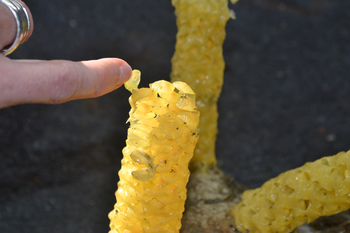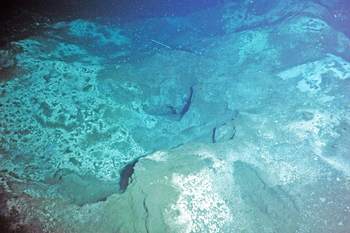One of the most startling discoveries was at a place called ‘Neptunea’s Nursery’.
For the past two days we have been working at one of the best know methane seep sites known called ‘Southern Hydrate Ridge’. It has been studied for numerous years by geologists, chemists and biologists because it hosts extensive bacterial mats, large bubble plumes of methane issuing from the seafloor, and abundant macrofauna – many supported by microbial symbionts.
Here, there are methane hydrate deposits both beneath the seafloor and at the surface, which are composed of ice hosting trapped molecules of methane in a lattice-like structure. This compound is unstable and releases methane from deep beneath the seafloor. The bubbles rise to the sediment-ocean water interface and are expelled as large plumes of streaming bubbles, which themselves become encased in a thin layer of hydrate as they rapidly rise in the water column – sometimes issuing as large bursts of gas from caverns in the sediment mounds.
Like hydrothermal vents, these systems are rich in chemosynthetic microorganisms that do not derive their energy from the sun, but instead from methane and hydrogen sulfide seeping from the sediments. We have been working at an active site called Einstein’s Grotto, which hosts a digital still camera, two flow meters that measure the rate of flow of fluids into and out of the sedimented seafloor, a mass spectrometer, upward-looking acoustic Doppler current profiler to image the bubble plumes and currents, and fluid samplers to look at chemistry over time. Short-period seismometers, arranged in a triangular array provide information on the impact of seismic events on methane release.All instruments are cabled as part of NSF's Ocean Observatories Initiative and streaming live data to shore.
The hummocky topography that characterizes this environment changes nearly daily, and methane plumes form and disappear several times a day - which is why a digital still camera was installed. Today we found a large collapse area that has formed between last year’s expedition and this year, another collapse zone hosting methane ice at the seafloor, has expanded to over 120 feet across and >6 feet in depth, and bacterial mats have migrated to new sites, while others have died.
One of the most startling discoveries was at a place called ‘Neptunea’s Nursery’. Last year, we found a large field of Neptunea snails tending beautiful beautiful yellow egg stacks that they had deposited.The large white snails were on top of the egg casings. Now, all the snails are gone and we thought that the casings were all devoid of eggs. To our delighted surprise, after recovering a couple stalks, we found that the eggs were still inside the casing, awaiting their time to hatch. It turns out that the eggs may take up to a year to hatch!




